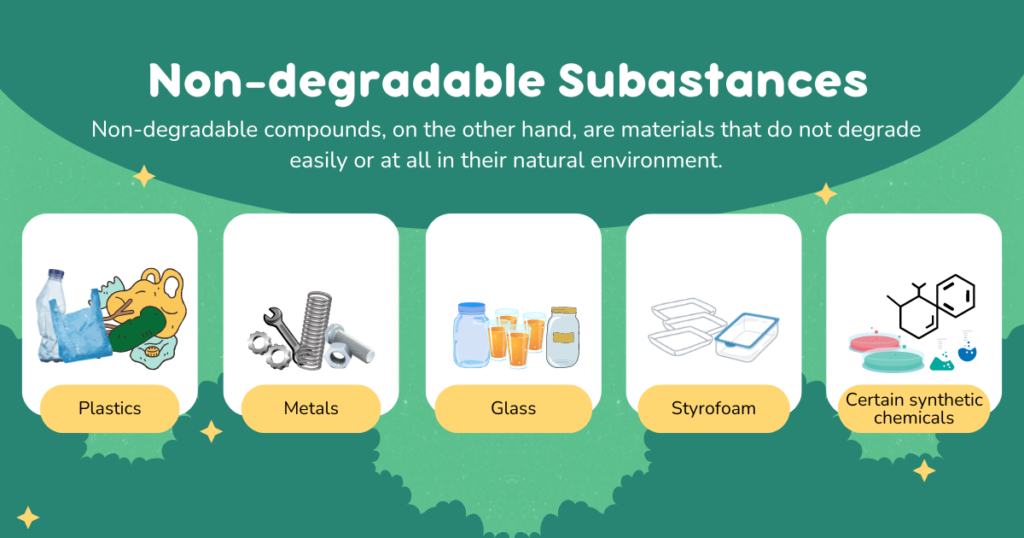Exploring the Environmental Impact of Waste and How Composting Can Drive a Sustainable Future
It is essential to comprehend the difference between degradable and non-degradable materials in the pursuit of a sustainable future. These substances have a big impact on the state of our ecosystem, having an impact on everything from pollution levels to soil fertility. Composting is a crucial activity that can reduce waste’s negative impacts while fostering ecological balance as we confront the problems of climate change and environmental degradation. The nature of biodegradable and non-biodegradable materials, their effects on the environment, and how composting can hold the key to building a sustainable future are all covered in the content of this blog.
Understanding Degradable Substances
Degradable substances are materials that degrade naturally over time due to biological activities. These include organic stuff such as food waste, leaves, paper, and certain bio-plastics. Microorganisms, moisture, and heat all help to decompose these molecules, converting them into simpler compounds that can be reabsorbed into the ecosystem.
When a banana peel is abandoned, microbes like bacteria and fungi begin to degrade it into water, carbon dioxide, and nutrient-rich organic matter known as humus. This humus nourishes the soil and encourages healthy plant development. The entire process might take from a few weeks to many months, depending on environmental factors such as temperature and humidity.

Examples of Degradable Substances:
-
Food scraps (vegetable peels, coffee grounds)
-
Yard waste (grass clippings, leaves)
-
Paper products (newspapers, cardboard)
-
Natural fibres (cotton, wool)
-
Certain bio-plastics
The decomposition of degradable substances is a natural part of the earth’s nutrient cycle, ensuring that organic matter is constantly recycled back into the environment. However, the rate at which these materials decompose can vary, influencing their environmental impact.
Non-Degradable Substances: A Growing Concern
Non-degradable compounds, on the other hand, are materials that do not degrade easily or at all in their natural environment. These include polymers, metals, glass, and certain synthetic compounds. Non-biodegradable substances, as opposed to biodegradable materials, can remain in the environment for hundreds or even thousands of years, accumulating in landfills, oceans, and other ecosystems.
The persistence of non-degradable chemicals presents considerable environmental challenges. For example, plastic bags, which are widely used around the world, can take up to 1,000 years to degrade. During this period, they degrade into tiny particles known as micro-plastics, which can enter soil, water, and the atmosphere, causing extensive pollution.
Examples of Non-Degradable Substances:
-
Plastics (bottles, bags, packaging)
-
Metals (cans, electronics)
-
Glass (bottles, windows)
-
Styrofoam (packaging materials, disposable cups)
-
Certain synthetic chemicals (pesticides, industrial solvents)
The accumulation of non-degradable substances in the environment leads to numerous issues, including habitat destruction, pollution of water bodies, and harm to wildlife. Moreover, these materials often end up in landfills, where they contribute to greenhouse gas emissions and other environmental hazards.
Degradable Vs. Non-Degradable Substances
When comparing degradable and non-degradable substances, several key differences emerge, particularly in terms of environmental impact:
- Decomposition Rate: Degradable substances degrade relatively fast, typically within weeks or months, whereas non-biodegradable substances might last for decades.
- Environmental Impact: Degradable substances contribute to the nutrient cycle, enriching the soil and encouraging plant development. However, non-biodegradable compounds can cause long-term environmental damage, such as pollution and habitat destruction.
- Recyclability: Many biodegradable materials can be composted, returning vital nutrients to the planet. Non-biodegradable substances, while recyclable, frequently necessitate specific methods and can still contribute to pollution if not managed effectively.
- Resource Use: The manufacture of non-biodegradable compounds frequently entails the extraction and use of finite resources such as oil and metals, which contributes to environmental damage. Degradable compounds, particularly those generated from organic sources, tend to have a smaller environmental impact.
Understanding these differences is essential for making informed decisions about waste management and environmental conservation.
The Environmental Impact of Non-Degradable Substances
The proliferation of non-degradable substances has led to severe environmental consequences. As these materials accumulate in the environment, they disrupt ecosystems and contribute to pollution on a global scale. The following are some of the most significant impacts of non-degradable substances:
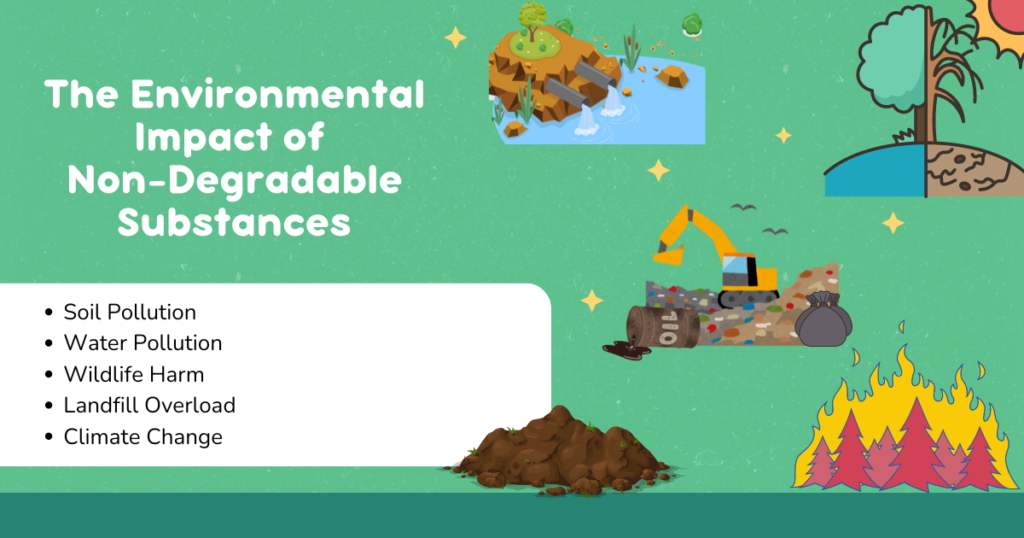
- Soil Pollution:
Non-degradable garbage, such as plastic bags and containers, can leach hazardous chemicals into the soil, polluting and lowering fertility. This pollution has the potential to alter plant development and soil ecosystem equilibrium.
- Water Pollution:
Non-degradable materials frequently make their way into rivers, lakes, and seas, where they inflict enormous damage. For example, the plastic waste in the oceans degrades into micro plastics, which are consumed by marine species, resulting in health problems and even death. This pollution also has an impact on human health, since micro plastics have been identified in seafood, drinking water, and even the air we breathe.
- Wildlife Harm:
Animals commonly confuse non-degradable garbage for food and become entangled in it. For example, marine species such as turtles, birds, and fish commonly consume plastic garbage, resulting in internal damage, malnutrition, and death. The accumulation of plastic garbage in the environment also endangers the survival of many animals by altering ecosystems and decreasing biodiversity.
- Landfill Overload:
Landfills are full of non-biodegradable rubbish, which takes up valuable space and contributes to environmental degradation. As landfills approach capacity, they emit methane, a strong greenhouse gas that contributes to climate change.
- Climate Change:
The manufacture and disposal of non-degradable materials, particularly plastics, contributes to greenhouse gas emissions. The exploitation of fossil fuels for plastic production, combined with the incineration of plastic trash, emits CO2 and other pollutants into the atmosphere, worsening global warming.
Composting: A Sustainable Solution
Dealing with these issues, composting emerges as an effective waste management and environmental sustainability technique. Composting is the natural process of converting organic matter, such as food scraps and yard trash, into a beneficial fertilizer that can improve soil quality and encourage healthy plant development. This procedure not only minimizes waste sent to landfills, but it also lessens the environmental impact of waste disposal.
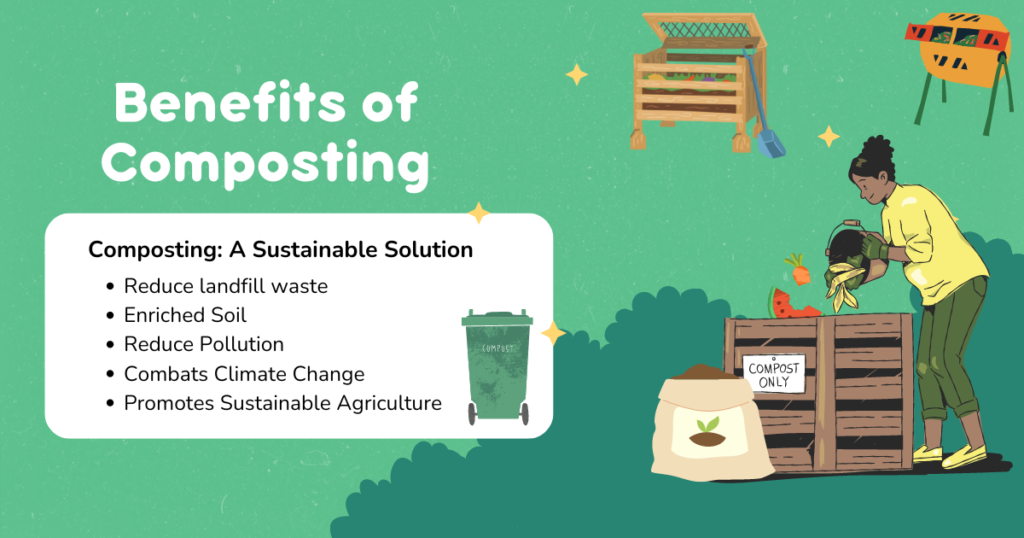
Benefits of Composting:
- Reduces Landfill Waste: By diverting organic waste from landfills, composting helps reduce the burden on these facilities, minimizing the release of harmful greenhouse gases like methane.
- Enriches Soil: Compost adds essential nutrients to the soil, improving its structure and fertility. This enriched soil supports healthy plant growth, leading to higher crop yields and more resilient ecosystems.
- Reduces Pollution: Composting reduces the need for chemical fertilizers, which can leach into waterways and cause pollution. By using compost, we can decrease our reliance on these harmful substances, promoting cleaner water and healthier ecosystems.
- Combats Climate Change: Composting sequesters carbon in the soil, reducing the amount of carbon dioxide in the atmosphere. This process helps combat climate change by reducing greenhouse gas emissions and promoting carbon storage in the soil.
- Promotes Sustainable Agriculture: Composting supports sustainable farming practices by providing a natural, renewable source of fertilizer. This approach reduces the need for synthetic inputs, promoting a healthier and more resilient agricultural system.
The Future of Composting
As we move toward a more sustainable future, composting will play an increasingly important role in waste management and environmental conservation. Governments, businesses, and individuals are recognizing the value of composting and are implementing programs and initiatives to promote this practice.
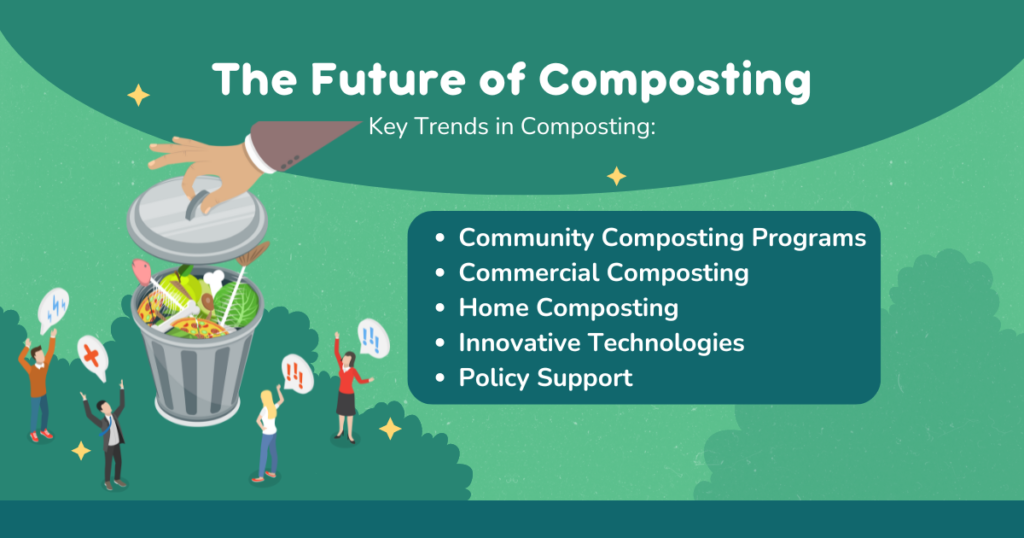
Key Trends in Composting:
- Community Composting Programs: Many cities and municipalities are launching community composting programs to help residents recycle their organic waste. These programs are frequently complemented by teaching activities that inform people about the benefits of composting and how to do it properly.
- Commercial Composting: Businesses are also getting into composting, with numerous companies providing composting services for food waste and other organic products. This trend is especially evident in the food industry, as restaurants and grocery stores are seeking for ways to lessen their environmental footprint.
- Home Composting: Composting at home is becoming increasingly popular, with people utilizing basic tools and procedures to recycle kitchen scraps and yard trash. Composting at home not only eliminates waste, but it also serves as a vital fertilizer for plants and lawns.
- Innovative Technologies: Composting technology advancements make composting a variety of materials easier and more efficient. Solar compost machines and automated composting systems, for example, are helping to speed up the process and increase the amount of garbage that may be composted.
- Policy Support: Governments are increasingly recognizing the benefits of composting and establishing legislation to encourage it. Some localities, for example, have enacted mandatory composting regulations, requiring households and companies to separate organic waste for composting.
Conclusion: Composting as the Future of Sustainability
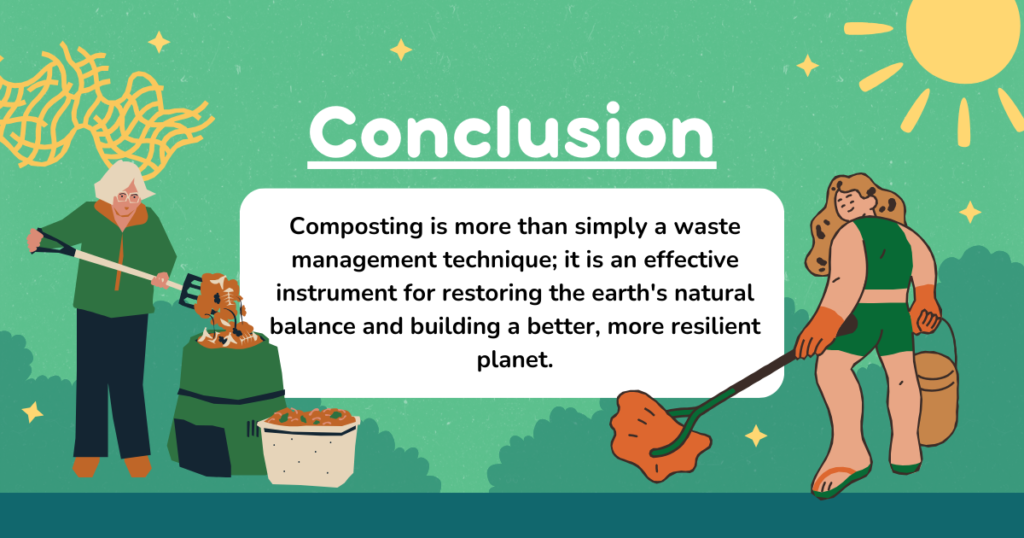
The challenges that are offered by non-biodegradable chemicals are serious, but not insurmountable. By embracing composting and other sustainable practices, we may reduce waste’s environmental impact, encourage healthy ecosystems, and work toward a more sustainable future. Composting is more than simply a waste management technique; it is an effective instrument for restoring the earth’s natural balance and building a better, more resilient planet.
As more people, businesses, and governments discover the benefits of composting, it will become an increasingly important part of our environmental efforts. We can all benefit from a more sustainable and wealthy future if we convert garbage into valuable resources.

